Comprehensive Fall Prevention Strategies for Geriatric Patients Report
VerifiedAdded on 2020/05/16
|14
|3988
|275
Report
AI Summary
This report delves into the critical issue of fall prevention strategies for geriatric patients, recognizing falls as a leading cause of injury and a significant concern in healthcare settings. It highlights the vulnerability of the elderly population, discussing the increasing life expectancy and associated chronic disorders that heighten the risk of falls. The report identifies intrinsic factors like age-related changes affecting balance and mobility, extrinsic factors such as environmental hazards, and situational factors that contribute to falls. It also examines the complications of falls, including loss of independence, injuries, and increased healthcare costs. The report emphasizes the importance of nursing professionals in implementing strategies to mitigate fall risks, such as proper patient assessment, environmental modifications, and the use of assistive devices. The report stresses the importance of person-centered care and the need for a comprehensive approach to ensure patient safety and improve quality of life for geriatric patients.
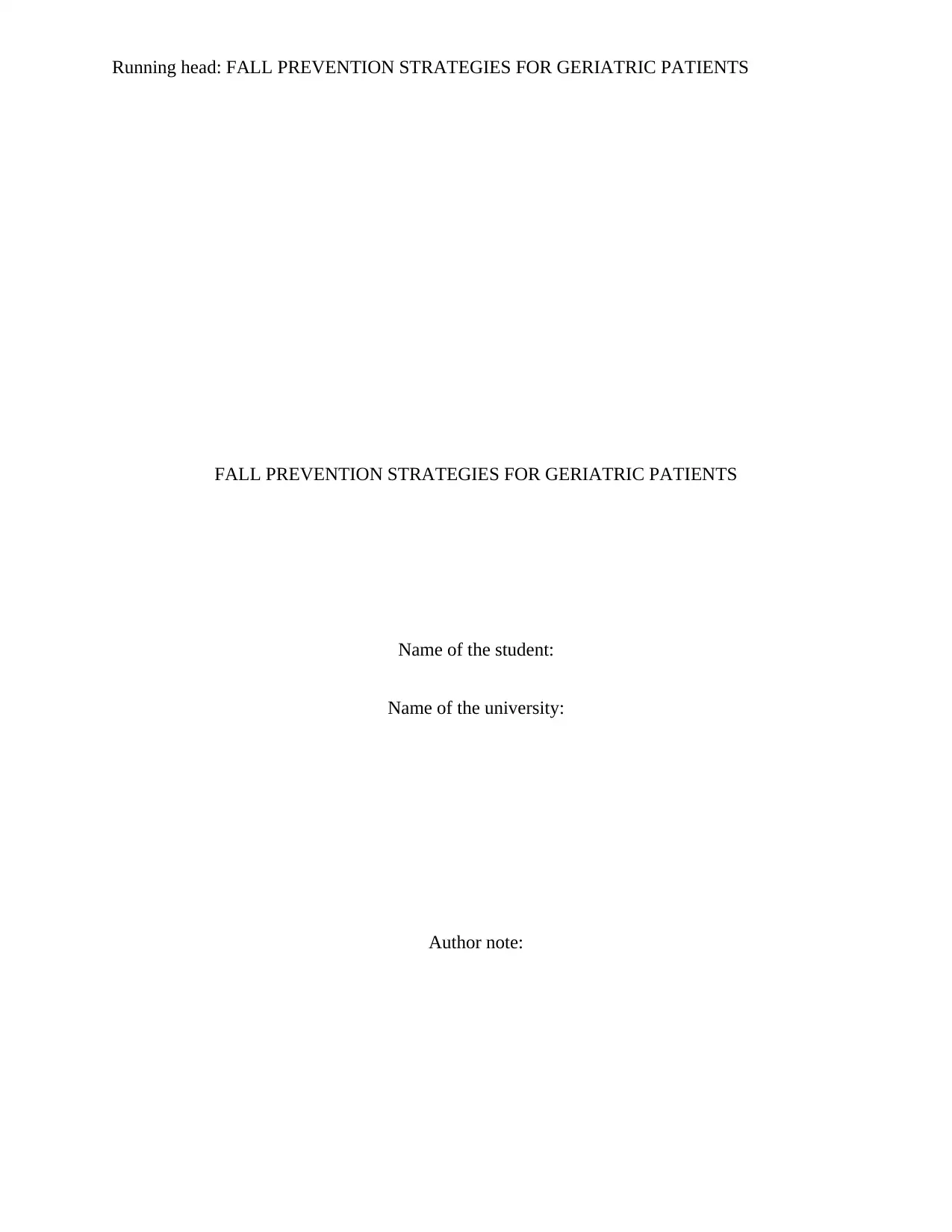
Running head: FALL PREVENTION STRATEGIES FOR GERIATRIC PATIENTS
FALL PREVENTION STRATEGIES FOR GERIATRIC PATIENTS
Name of the student:
Name of the university:
Author note:
FALL PREVENTION STRATEGIES FOR GERIATRIC PATIENTS
Name of the student:
Name of the university:
Author note:
Paraphrase This Document
Need a fresh take? Get an instant paraphrase of this document with our AI Paraphraser
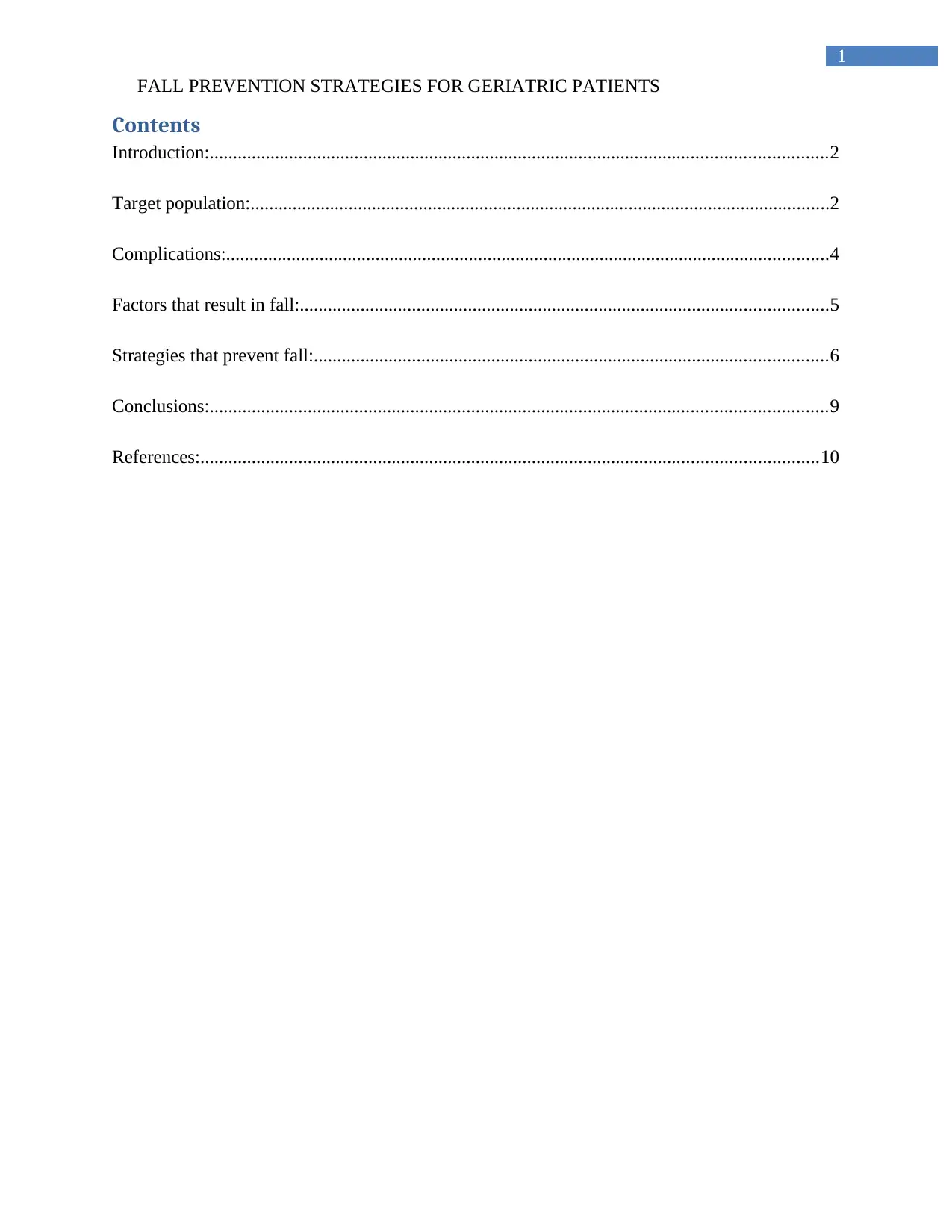
1
FALL PREVENTION STRATEGIES FOR GERIATRIC PATIENTS
Contents
Introduction:....................................................................................................................................2
Target population:............................................................................................................................2
Complications:.................................................................................................................................4
Factors that result in fall:.................................................................................................................5
Strategies that prevent fall:..............................................................................................................6
Conclusions:....................................................................................................................................9
References:....................................................................................................................................10
FALL PREVENTION STRATEGIES FOR GERIATRIC PATIENTS
Contents
Introduction:....................................................................................................................................2
Target population:............................................................................................................................2
Complications:.................................................................................................................................4
Factors that result in fall:.................................................................................................................5
Strategies that prevent fall:..............................................................................................................6
Conclusions:....................................................................................................................................9
References:....................................................................................................................................10
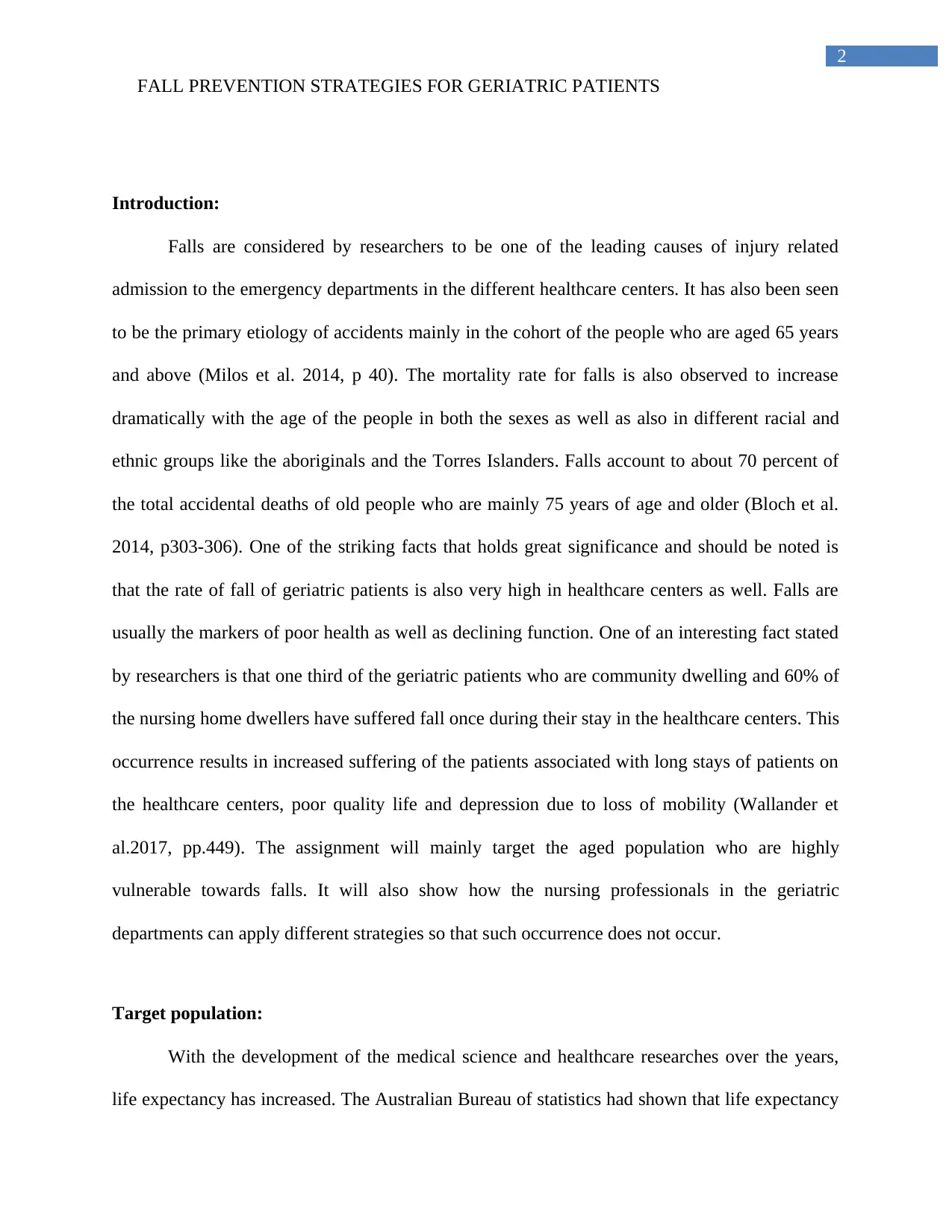
2
FALL PREVENTION STRATEGIES FOR GERIATRIC PATIENTS
Introduction:
Falls are considered by researchers to be one of the leading causes of injury related
admission to the emergency departments in the different healthcare centers. It has also been seen
to be the primary etiology of accidents mainly in the cohort of the people who are aged 65 years
and above (Milos et al. 2014, p 40). The mortality rate for falls is also observed to increase
dramatically with the age of the people in both the sexes as well as also in different racial and
ethnic groups like the aboriginals and the Torres Islanders. Falls account to about 70 percent of
the total accidental deaths of old people who are mainly 75 years of age and older (Bloch et al.
2014, p303-306). One of the striking facts that holds great significance and should be noted is
that the rate of fall of geriatric patients is also very high in healthcare centers as well. Falls are
usually the markers of poor health as well as declining function. One of an interesting fact stated
by researchers is that one third of the geriatric patients who are community dwelling and 60% of
the nursing home dwellers have suffered fall once during their stay in the healthcare centers. This
occurrence results in increased suffering of the patients associated with long stays of patients on
the healthcare centers, poor quality life and depression due to loss of mobility (Wallander et
al.2017, pp.449). The assignment will mainly target the aged population who are highly
vulnerable towards falls. It will also show how the nursing professionals in the geriatric
departments can apply different strategies so that such occurrence does not occur.
Target population:
With the development of the medical science and healthcare researches over the years,
life expectancy has increased. The Australian Bureau of statistics had shown that life expectancy
FALL PREVENTION STRATEGIES FOR GERIATRIC PATIENTS
Introduction:
Falls are considered by researchers to be one of the leading causes of injury related
admission to the emergency departments in the different healthcare centers. It has also been seen
to be the primary etiology of accidents mainly in the cohort of the people who are aged 65 years
and above (Milos et al. 2014, p 40). The mortality rate for falls is also observed to increase
dramatically with the age of the people in both the sexes as well as also in different racial and
ethnic groups like the aboriginals and the Torres Islanders. Falls account to about 70 percent of
the total accidental deaths of old people who are mainly 75 years of age and older (Bloch et al.
2014, p303-306). One of the striking facts that holds great significance and should be noted is
that the rate of fall of geriatric patients is also very high in healthcare centers as well. Falls are
usually the markers of poor health as well as declining function. One of an interesting fact stated
by researchers is that one third of the geriatric patients who are community dwelling and 60% of
the nursing home dwellers have suffered fall once during their stay in the healthcare centers. This
occurrence results in increased suffering of the patients associated with long stays of patients on
the healthcare centers, poor quality life and depression due to loss of mobility (Wallander et
al.2017, pp.449). The assignment will mainly target the aged population who are highly
vulnerable towards falls. It will also show how the nursing professionals in the geriatric
departments can apply different strategies so that such occurrence does not occur.
Target population:
With the development of the medical science and healthcare researches over the years,
life expectancy has increased. The Australian Bureau of statistics had shown that life expectancy
⊘ This is a preview!⊘
Do you want full access?
Subscribe today to unlock all pages.

Trusted by 1+ million students worldwide
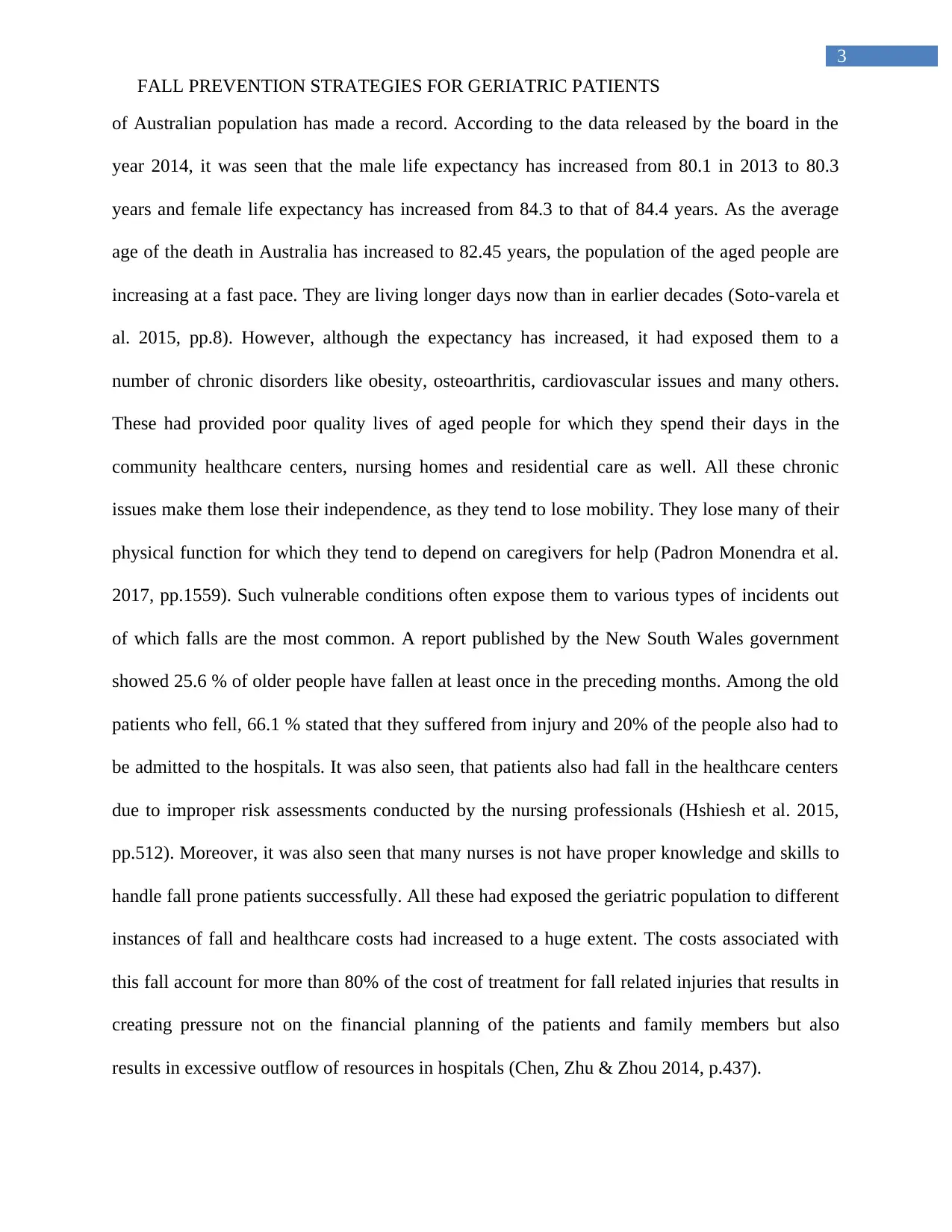
3
FALL PREVENTION STRATEGIES FOR GERIATRIC PATIENTS
of Australian population has made a record. According to the data released by the board in the
year 2014, it was seen that the male life expectancy has increased from 80.1 in 2013 to 80.3
years and female life expectancy has increased from 84.3 to that of 84.4 years. As the average
age of the death in Australia has increased to 82.45 years, the population of the aged people are
increasing at a fast pace. They are living longer days now than in earlier decades (Soto-varela et
al. 2015, pp.8). However, although the expectancy has increased, it had exposed them to a
number of chronic disorders like obesity, osteoarthritis, cardiovascular issues and many others.
These had provided poor quality lives of aged people for which they spend their days in the
community healthcare centers, nursing homes and residential care as well. All these chronic
issues make them lose their independence, as they tend to lose mobility. They lose many of their
physical function for which they tend to depend on caregivers for help (Padron Monendra et al.
2017, pp.1559). Such vulnerable conditions often expose them to various types of incidents out
of which falls are the most common. A report published by the New South Wales government
showed 25.6 % of older people have fallen at least once in the preceding months. Among the old
patients who fell, 66.1 % stated that they suffered from injury and 20% of the people also had to
be admitted to the hospitals. It was also seen, that patients also had fall in the healthcare centers
due to improper risk assessments conducted by the nursing professionals (Hshiesh et al. 2015,
pp.512). Moreover, it was also seen that many nurses is not have proper knowledge and skills to
handle fall prone patients successfully. All these had exposed the geriatric population to different
instances of fall and healthcare costs had increased to a huge extent. The costs associated with
this fall account for more than 80% of the cost of treatment for fall related injuries that results in
creating pressure not on the financial planning of the patients and family members but also
results in excessive outflow of resources in hospitals (Chen, Zhu & Zhou 2014, p.437).
FALL PREVENTION STRATEGIES FOR GERIATRIC PATIENTS
of Australian population has made a record. According to the data released by the board in the
year 2014, it was seen that the male life expectancy has increased from 80.1 in 2013 to 80.3
years and female life expectancy has increased from 84.3 to that of 84.4 years. As the average
age of the death in Australia has increased to 82.45 years, the population of the aged people are
increasing at a fast pace. They are living longer days now than in earlier decades (Soto-varela et
al. 2015, pp.8). However, although the expectancy has increased, it had exposed them to a
number of chronic disorders like obesity, osteoarthritis, cardiovascular issues and many others.
These had provided poor quality lives of aged people for which they spend their days in the
community healthcare centers, nursing homes and residential care as well. All these chronic
issues make them lose their independence, as they tend to lose mobility. They lose many of their
physical function for which they tend to depend on caregivers for help (Padron Monendra et al.
2017, pp.1559). Such vulnerable conditions often expose them to various types of incidents out
of which falls are the most common. A report published by the New South Wales government
showed 25.6 % of older people have fallen at least once in the preceding months. Among the old
patients who fell, 66.1 % stated that they suffered from injury and 20% of the people also had to
be admitted to the hospitals. It was also seen, that patients also had fall in the healthcare centers
due to improper risk assessments conducted by the nursing professionals (Hshiesh et al. 2015,
pp.512). Moreover, it was also seen that many nurses is not have proper knowledge and skills to
handle fall prone patients successfully. All these had exposed the geriatric population to different
instances of fall and healthcare costs had increased to a huge extent. The costs associated with
this fall account for more than 80% of the cost of treatment for fall related injuries that results in
creating pressure not on the financial planning of the patients and family members but also
results in excessive outflow of resources in hospitals (Chen, Zhu & Zhou 2014, p.437).
Paraphrase This Document
Need a fresh take? Get an instant paraphrase of this document with our AI Paraphraser
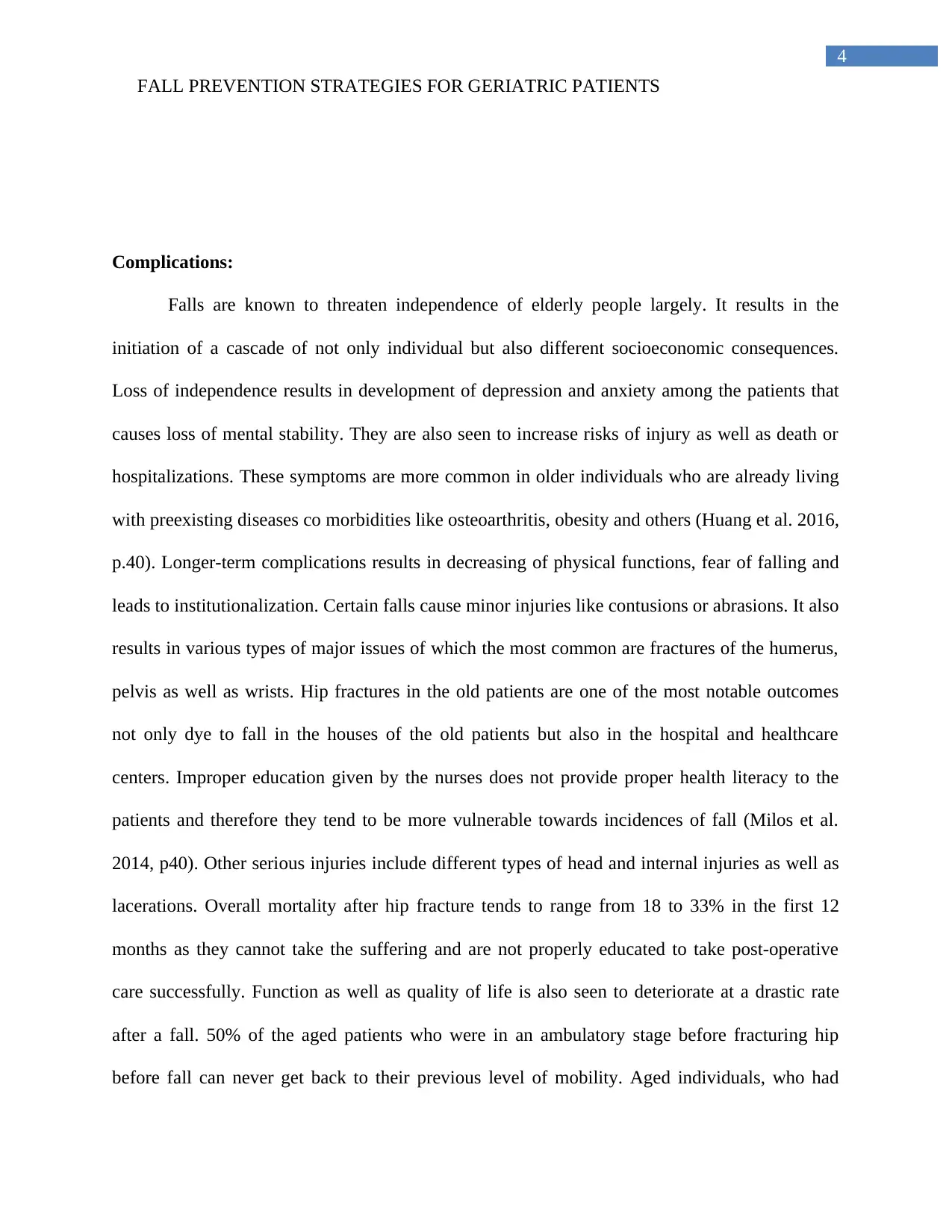
4
FALL PREVENTION STRATEGIES FOR GERIATRIC PATIENTS
Complications:
Falls are known to threaten independence of elderly people largely. It results in the
initiation of a cascade of not only individual but also different socioeconomic consequences.
Loss of independence results in development of depression and anxiety among the patients that
causes loss of mental stability. They are also seen to increase risks of injury as well as death or
hospitalizations. These symptoms are more common in older individuals who are already living
with preexisting diseases co morbidities like osteoarthritis, obesity and others (Huang et al. 2016,
p.40). Longer-term complications results in decreasing of physical functions, fear of falling and
leads to institutionalization. Certain falls cause minor injuries like contusions or abrasions. It also
results in various types of major issues of which the most common are fractures of the humerus,
pelvis as well as wrists. Hip fractures in the old patients are one of the most notable outcomes
not only dye to fall in the houses of the old patients but also in the hospital and healthcare
centers. Improper education given by the nurses does not provide proper health literacy to the
patients and therefore they tend to be more vulnerable towards incidences of fall (Milos et al.
2014, p40). Other serious injuries include different types of head and internal injuries as well as
lacerations. Overall mortality after hip fracture tends to range from 18 to 33% in the first 12
months as they cannot take the suffering and are not properly educated to take post-operative
care successfully. Function as well as quality of life is also seen to deteriorate at a drastic rate
after a fall. 50% of the aged patients who were in an ambulatory stage before fracturing hip
before fall can never get back to their previous level of mobility. Aged individuals, who had
FALL PREVENTION STRATEGIES FOR GERIATRIC PATIENTS
Complications:
Falls are known to threaten independence of elderly people largely. It results in the
initiation of a cascade of not only individual but also different socioeconomic consequences.
Loss of independence results in development of depression and anxiety among the patients that
causes loss of mental stability. They are also seen to increase risks of injury as well as death or
hospitalizations. These symptoms are more common in older individuals who are already living
with preexisting diseases co morbidities like osteoarthritis, obesity and others (Huang et al. 2016,
p.40). Longer-term complications results in decreasing of physical functions, fear of falling and
leads to institutionalization. Certain falls cause minor injuries like contusions or abrasions. It also
results in various types of major issues of which the most common are fractures of the humerus,
pelvis as well as wrists. Hip fractures in the old patients are one of the most notable outcomes
not only dye to fall in the houses of the old patients but also in the hospital and healthcare
centers. Improper education given by the nurses does not provide proper health literacy to the
patients and therefore they tend to be more vulnerable towards incidences of fall (Milos et al.
2014, p40). Other serious injuries include different types of head and internal injuries as well as
lacerations. Overall mortality after hip fracture tends to range from 18 to 33% in the first 12
months as they cannot take the suffering and are not properly educated to take post-operative
care successfully. Function as well as quality of life is also seen to deteriorate at a drastic rate
after a fall. 50% of the aged patients who were in an ambulatory stage before fracturing hip
before fall can never get back to their previous level of mobility. Aged individuals, who had
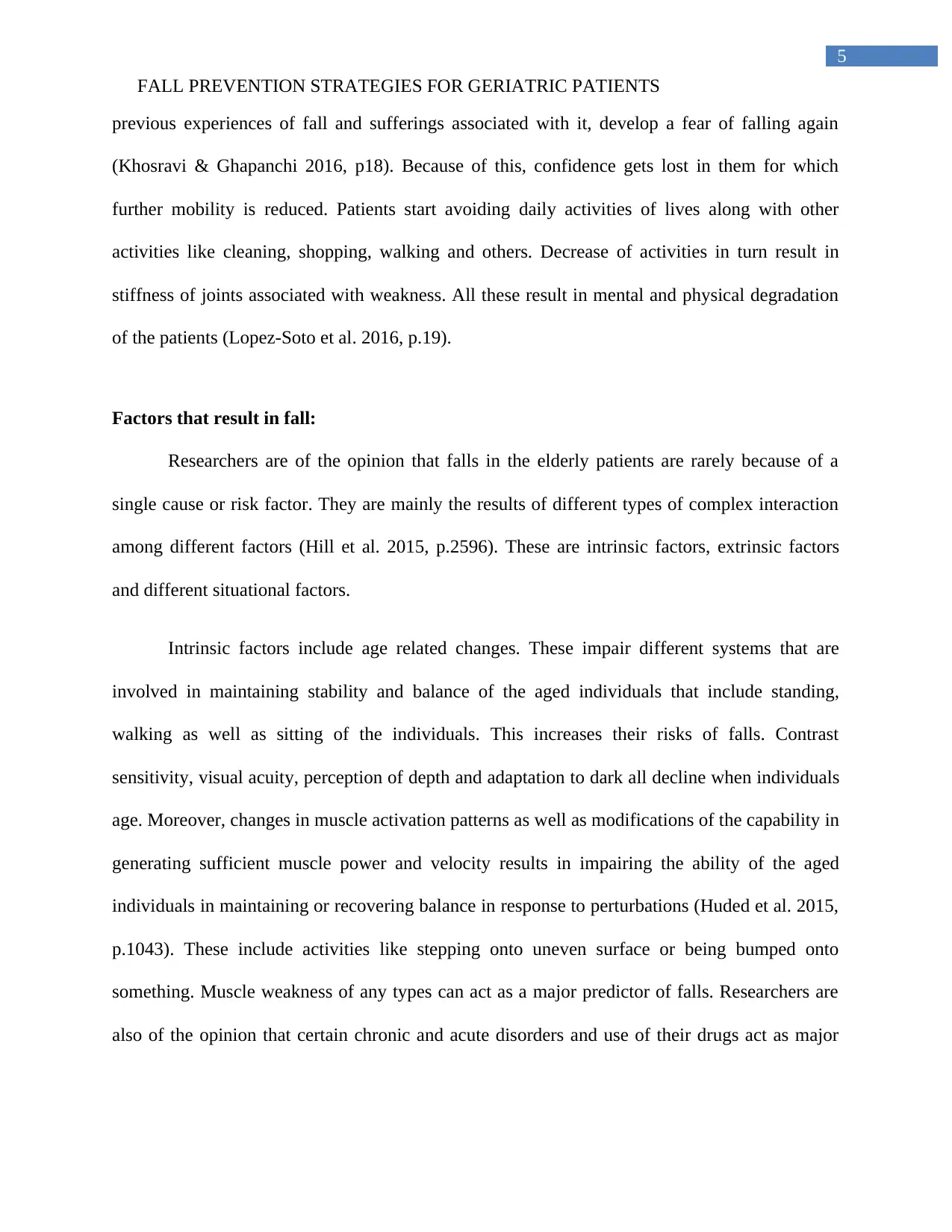
5
FALL PREVENTION STRATEGIES FOR GERIATRIC PATIENTS
previous experiences of fall and sufferings associated with it, develop a fear of falling again
(Khosravi & Ghapanchi 2016, p18). Because of this, confidence gets lost in them for which
further mobility is reduced. Patients start avoiding daily activities of lives along with other
activities like cleaning, shopping, walking and others. Decrease of activities in turn result in
stiffness of joints associated with weakness. All these result in mental and physical degradation
of the patients (Lopez-Soto et al. 2016, p.19).
Factors that result in fall:
Researchers are of the opinion that falls in the elderly patients are rarely because of a
single cause or risk factor. They are mainly the results of different types of complex interaction
among different factors (Hill et al. 2015, p.2596). These are intrinsic factors, extrinsic factors
and different situational factors.
Intrinsic factors include age related changes. These impair different systems that are
involved in maintaining stability and balance of the aged individuals that include standing,
walking as well as sitting of the individuals. This increases their risks of falls. Contrast
sensitivity, visual acuity, perception of depth and adaptation to dark all decline when individuals
age. Moreover, changes in muscle activation patterns as well as modifications of the capability in
generating sufficient muscle power and velocity results in impairing the ability of the aged
individuals in maintaining or recovering balance in response to perturbations (Huded et al. 2015,
p.1043). These include activities like stepping onto uneven surface or being bumped onto
something. Muscle weakness of any types can act as a major predictor of falls. Researchers are
also of the opinion that certain chronic and acute disorders and use of their drugs act as major
FALL PREVENTION STRATEGIES FOR GERIATRIC PATIENTS
previous experiences of fall and sufferings associated with it, develop a fear of falling again
(Khosravi & Ghapanchi 2016, p18). Because of this, confidence gets lost in them for which
further mobility is reduced. Patients start avoiding daily activities of lives along with other
activities like cleaning, shopping, walking and others. Decrease of activities in turn result in
stiffness of joints associated with weakness. All these result in mental and physical degradation
of the patients (Lopez-Soto et al. 2016, p.19).
Factors that result in fall:
Researchers are of the opinion that falls in the elderly patients are rarely because of a
single cause or risk factor. They are mainly the results of different types of complex interaction
among different factors (Hill et al. 2015, p.2596). These are intrinsic factors, extrinsic factors
and different situational factors.
Intrinsic factors include age related changes. These impair different systems that are
involved in maintaining stability and balance of the aged individuals that include standing,
walking as well as sitting of the individuals. This increases their risks of falls. Contrast
sensitivity, visual acuity, perception of depth and adaptation to dark all decline when individuals
age. Moreover, changes in muscle activation patterns as well as modifications of the capability in
generating sufficient muscle power and velocity results in impairing the ability of the aged
individuals in maintaining or recovering balance in response to perturbations (Huded et al. 2015,
p.1043). These include activities like stepping onto uneven surface or being bumped onto
something. Muscle weakness of any types can act as a major predictor of falls. Researchers are
also of the opinion that certain chronic and acute disorders and use of their drugs act as major
⊘ This is a preview!⊘
Do you want full access?
Subscribe today to unlock all pages.

Trusted by 1+ million students worldwide
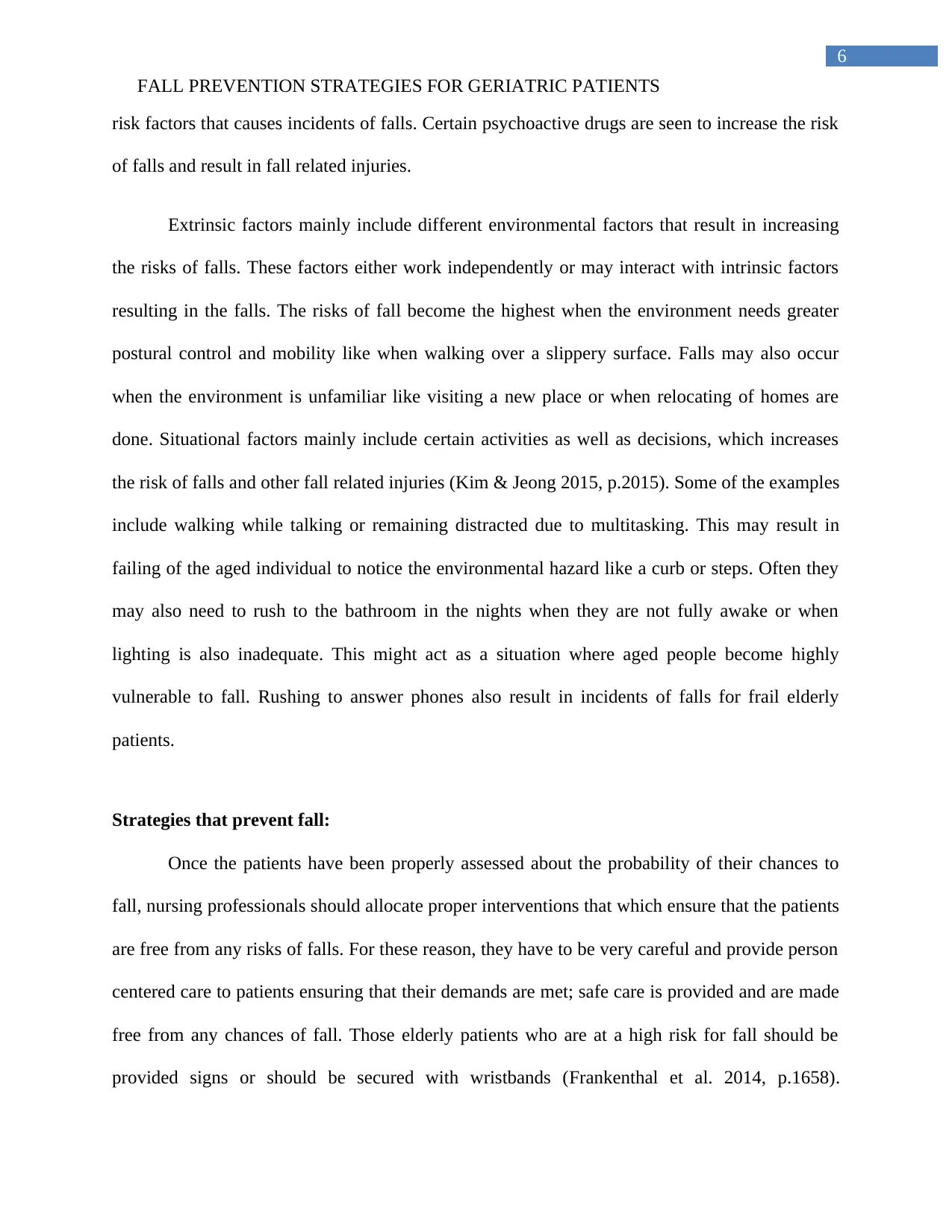
6
FALL PREVENTION STRATEGIES FOR GERIATRIC PATIENTS
risk factors that causes incidents of falls. Certain psychoactive drugs are seen to increase the risk
of falls and result in fall related injuries.
Extrinsic factors mainly include different environmental factors that result in increasing
the risks of falls. These factors either work independently or may interact with intrinsic factors
resulting in the falls. The risks of fall become the highest when the environment needs greater
postural control and mobility like when walking over a slippery surface. Falls may also occur
when the environment is unfamiliar like visiting a new place or when relocating of homes are
done. Situational factors mainly include certain activities as well as decisions, which increases
the risk of falls and other fall related injuries (Kim & Jeong 2015, p.2015). Some of the examples
include walking while talking or remaining distracted due to multitasking. This may result in
failing of the aged individual to notice the environmental hazard like a curb or steps. Often they
may also need to rush to the bathroom in the nights when they are not fully awake or when
lighting is also inadequate. This might act as a situation where aged people become highly
vulnerable to fall. Rushing to answer phones also result in incidents of falls for frail elderly
patients.
Strategies that prevent fall:
Once the patients have been properly assessed about the probability of their chances to
fall, nursing professionals should allocate proper interventions that which ensure that the patients
are free from any risks of falls. For these reason, they have to be very careful and provide person
centered care to patients ensuring that their demands are met; safe care is provided and are made
free from any chances of fall. Those elderly patients who are at a high risk for fall should be
provided signs or should be secured with wristbands (Frankenthal et al. 2014, p.1658).
FALL PREVENTION STRATEGIES FOR GERIATRIC PATIENTS
risk factors that causes incidents of falls. Certain psychoactive drugs are seen to increase the risk
of falls and result in fall related injuries.
Extrinsic factors mainly include different environmental factors that result in increasing
the risks of falls. These factors either work independently or may interact with intrinsic factors
resulting in the falls. The risks of fall become the highest when the environment needs greater
postural control and mobility like when walking over a slippery surface. Falls may also occur
when the environment is unfamiliar like visiting a new place or when relocating of homes are
done. Situational factors mainly include certain activities as well as decisions, which increases
the risk of falls and other fall related injuries (Kim & Jeong 2015, p.2015). Some of the examples
include walking while talking or remaining distracted due to multitasking. This may result in
failing of the aged individual to notice the environmental hazard like a curb or steps. Often they
may also need to rush to the bathroom in the nights when they are not fully awake or when
lighting is also inadequate. This might act as a situation where aged people become highly
vulnerable to fall. Rushing to answer phones also result in incidents of falls for frail elderly
patients.
Strategies that prevent fall:
Once the patients have been properly assessed about the probability of their chances to
fall, nursing professionals should allocate proper interventions that which ensure that the patients
are free from any risks of falls. For these reason, they have to be very careful and provide person
centered care to patients ensuring that their demands are met; safe care is provided and are made
free from any chances of fall. Those elderly patients who are at a high risk for fall should be
provided signs or should be secured with wristbands (Frankenthal et al. 2014, p.1658).
Paraphrase This Document
Need a fresh take? Get an instant paraphrase of this document with our AI Paraphraser
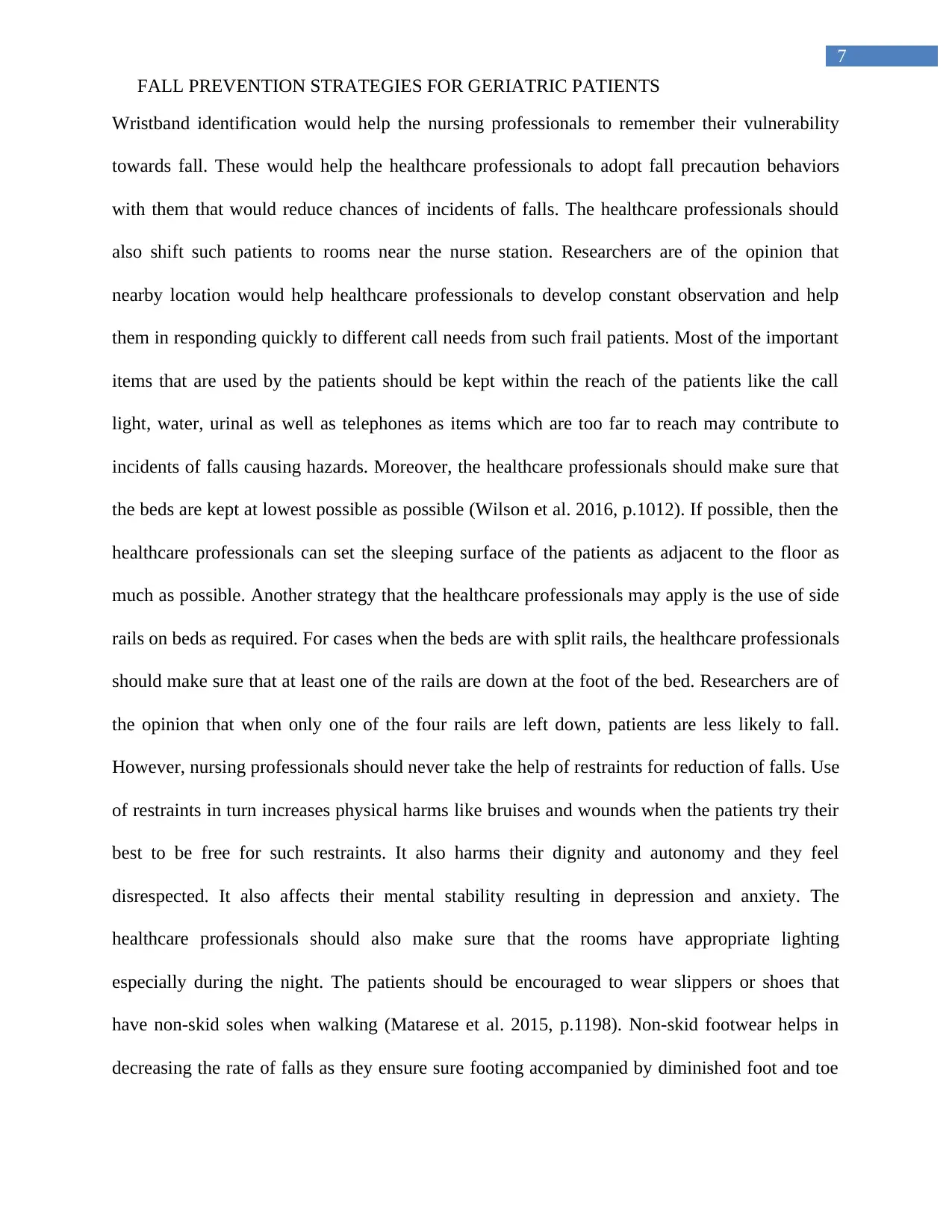
7
FALL PREVENTION STRATEGIES FOR GERIATRIC PATIENTS
Wristband identification would help the nursing professionals to remember their vulnerability
towards fall. These would help the healthcare professionals to adopt fall precaution behaviors
with them that would reduce chances of incidents of falls. The healthcare professionals should
also shift such patients to rooms near the nurse station. Researchers are of the opinion that
nearby location would help healthcare professionals to develop constant observation and help
them in responding quickly to different call needs from such frail patients. Most of the important
items that are used by the patients should be kept within the reach of the patients like the call
light, water, urinal as well as telephones as items which are too far to reach may contribute to
incidents of falls causing hazards. Moreover, the healthcare professionals should make sure that
the beds are kept at lowest possible as possible (Wilson et al. 2016, p.1012). If possible, then the
healthcare professionals can set the sleeping surface of the patients as adjacent to the floor as
much as possible. Another strategy that the healthcare professionals may apply is the use of side
rails on beds as required. For cases when the beds are with split rails, the healthcare professionals
should make sure that at least one of the rails are down at the foot of the bed. Researchers are of
the opinion that when only one of the four rails are left down, patients are less likely to fall.
However, nursing professionals should never take the help of restraints for reduction of falls. Use
of restraints in turn increases physical harms like bruises and wounds when the patients try their
best to be free for such restraints. It also harms their dignity and autonomy and they feel
disrespected. It also affects their mental stability resulting in depression and anxiety. The
healthcare professionals should also make sure that the rooms have appropriate lighting
especially during the night. The patients should be encouraged to wear slippers or shoes that
have non-skid soles when walking (Matarese et al. 2015, p.1198). Non-skid footwear helps in
decreasing the rate of falls as they ensure sure footing accompanied by diminished foot and toe
FALL PREVENTION STRATEGIES FOR GERIATRIC PATIENTS
Wristband identification would help the nursing professionals to remember their vulnerability
towards fall. These would help the healthcare professionals to adopt fall precaution behaviors
with them that would reduce chances of incidents of falls. The healthcare professionals should
also shift such patients to rooms near the nurse station. Researchers are of the opinion that
nearby location would help healthcare professionals to develop constant observation and help
them in responding quickly to different call needs from such frail patients. Most of the important
items that are used by the patients should be kept within the reach of the patients like the call
light, water, urinal as well as telephones as items which are too far to reach may contribute to
incidents of falls causing hazards. Moreover, the healthcare professionals should make sure that
the beds are kept at lowest possible as possible (Wilson et al. 2016, p.1012). If possible, then the
healthcare professionals can set the sleeping surface of the patients as adjacent to the floor as
much as possible. Another strategy that the healthcare professionals may apply is the use of side
rails on beds as required. For cases when the beds are with split rails, the healthcare professionals
should make sure that at least one of the rails are down at the foot of the bed. Researchers are of
the opinion that when only one of the four rails are left down, patients are less likely to fall.
However, nursing professionals should never take the help of restraints for reduction of falls. Use
of restraints in turn increases physical harms like bruises and wounds when the patients try their
best to be free for such restraints. It also harms their dignity and autonomy and they feel
disrespected. It also affects their mental stability resulting in depression and anxiety. The
healthcare professionals should also make sure that the rooms have appropriate lighting
especially during the night. The patients should be encouraged to wear slippers or shoes that
have non-skid soles when walking (Matarese et al. 2015, p.1198). Non-skid footwear helps in
decreasing the rate of falls as they ensure sure footing accompanied by diminished foot and toe
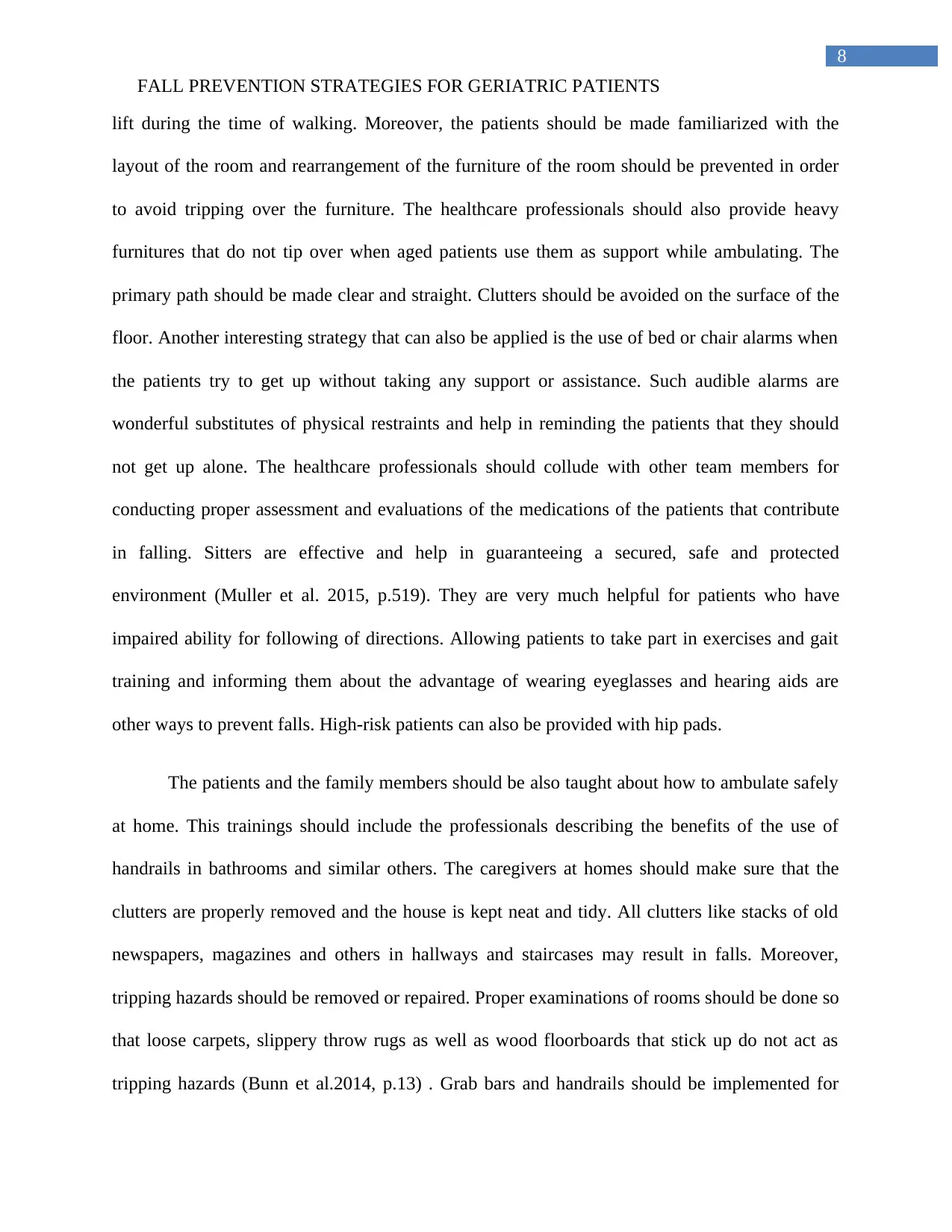
8
FALL PREVENTION STRATEGIES FOR GERIATRIC PATIENTS
lift during the time of walking. Moreover, the patients should be made familiarized with the
layout of the room and rearrangement of the furniture of the room should be prevented in order
to avoid tripping over the furniture. The healthcare professionals should also provide heavy
furnitures that do not tip over when aged patients use them as support while ambulating. The
primary path should be made clear and straight. Clutters should be avoided on the surface of the
floor. Another interesting strategy that can also be applied is the use of bed or chair alarms when
the patients try to get up without taking any support or assistance. Such audible alarms are
wonderful substitutes of physical restraints and help in reminding the patients that they should
not get up alone. The healthcare professionals should collude with other team members for
conducting proper assessment and evaluations of the medications of the patients that contribute
in falling. Sitters are effective and help in guaranteeing a secured, safe and protected
environment (Muller et al. 2015, p.519). They are very much helpful for patients who have
impaired ability for following of directions. Allowing patients to take part in exercises and gait
training and informing them about the advantage of wearing eyeglasses and hearing aids are
other ways to prevent falls. High-risk patients can also be provided with hip pads.
The patients and the family members should be also taught about how to ambulate safely
at home. This trainings should include the professionals describing the benefits of the use of
handrails in bathrooms and similar others. The caregivers at homes should make sure that the
clutters are properly removed and the house is kept neat and tidy. All clutters like stacks of old
newspapers, magazines and others in hallways and staircases may result in falls. Moreover,
tripping hazards should be removed or repaired. Proper examinations of rooms should be done so
that loose carpets, slippery throw rugs as well as wood floorboards that stick up do not act as
tripping hazards (Bunn et al.2014, p.13) . Grab bars and handrails should be implemented for
FALL PREVENTION STRATEGIES FOR GERIATRIC PATIENTS
lift during the time of walking. Moreover, the patients should be made familiarized with the
layout of the room and rearrangement of the furniture of the room should be prevented in order
to avoid tripping over the furniture. The healthcare professionals should also provide heavy
furnitures that do not tip over when aged patients use them as support while ambulating. The
primary path should be made clear and straight. Clutters should be avoided on the surface of the
floor. Another interesting strategy that can also be applied is the use of bed or chair alarms when
the patients try to get up without taking any support or assistance. Such audible alarms are
wonderful substitutes of physical restraints and help in reminding the patients that they should
not get up alone. The healthcare professionals should collude with other team members for
conducting proper assessment and evaluations of the medications of the patients that contribute
in falling. Sitters are effective and help in guaranteeing a secured, safe and protected
environment (Muller et al. 2015, p.519). They are very much helpful for patients who have
impaired ability for following of directions. Allowing patients to take part in exercises and gait
training and informing them about the advantage of wearing eyeglasses and hearing aids are
other ways to prevent falls. High-risk patients can also be provided with hip pads.
The patients and the family members should be also taught about how to ambulate safely
at home. This trainings should include the professionals describing the benefits of the use of
handrails in bathrooms and similar others. The caregivers at homes should make sure that the
clutters are properly removed and the house is kept neat and tidy. All clutters like stacks of old
newspapers, magazines and others in hallways and staircases may result in falls. Moreover,
tripping hazards should be removed or repaired. Proper examinations of rooms should be done so
that loose carpets, slippery throw rugs as well as wood floorboards that stick up do not act as
tripping hazards (Bunn et al.2014, p.13) . Grab bars and handrails should be implemented for
⊘ This is a preview!⊘
Do you want full access?
Subscribe today to unlock all pages.

Trusted by 1+ million students worldwide
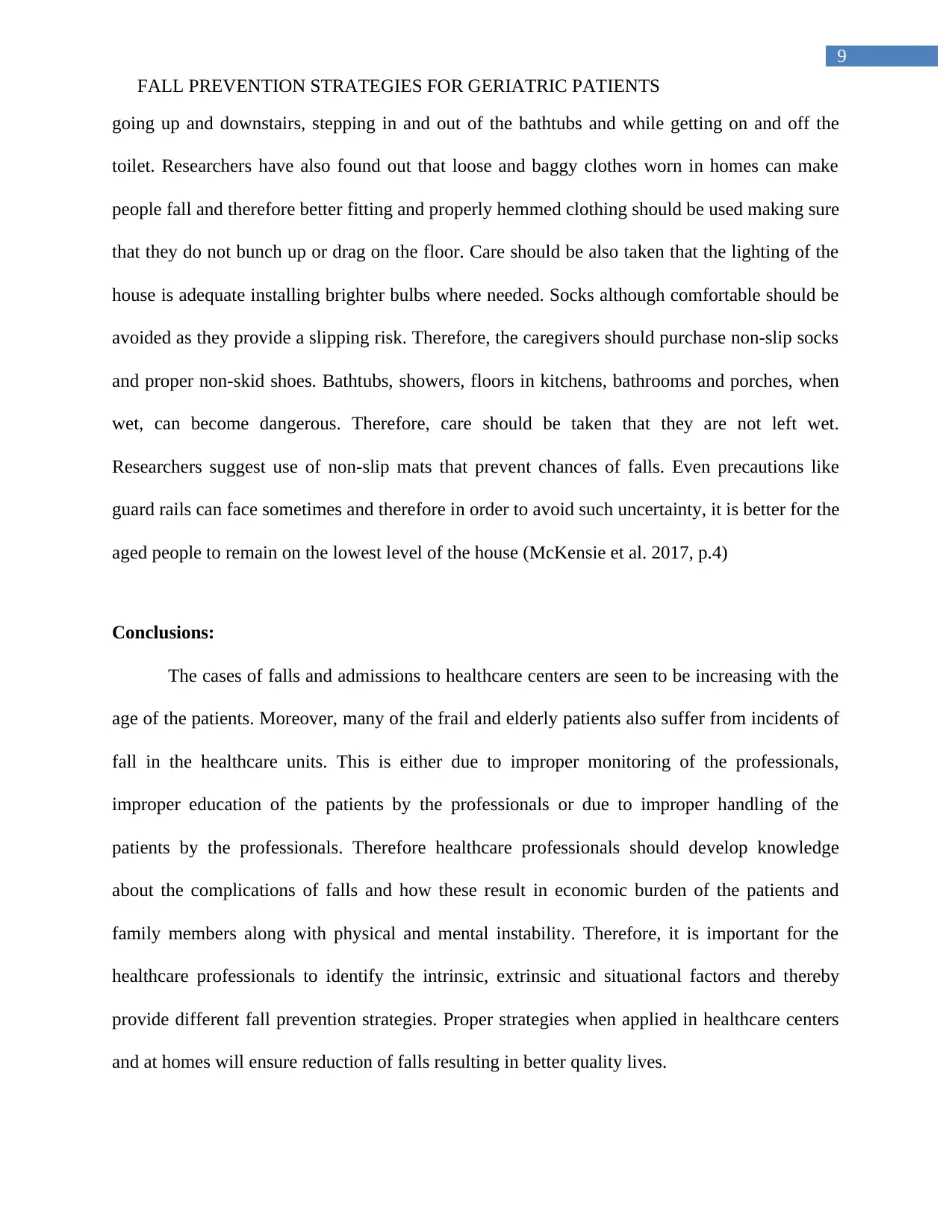
9
FALL PREVENTION STRATEGIES FOR GERIATRIC PATIENTS
going up and downstairs, stepping in and out of the bathtubs and while getting on and off the
toilet. Researchers have also found out that loose and baggy clothes worn in homes can make
people fall and therefore better fitting and properly hemmed clothing should be used making sure
that they do not bunch up or drag on the floor. Care should be also taken that the lighting of the
house is adequate installing brighter bulbs where needed. Socks although comfortable should be
avoided as they provide a slipping risk. Therefore, the caregivers should purchase non-slip socks
and proper non-skid shoes. Bathtubs, showers, floors in kitchens, bathrooms and porches, when
wet, can become dangerous. Therefore, care should be taken that they are not left wet.
Researchers suggest use of non-slip mats that prevent chances of falls. Even precautions like
guard rails can face sometimes and therefore in order to avoid such uncertainty, it is better for the
aged people to remain on the lowest level of the house (McKensie et al. 2017, p.4)
Conclusions:
The cases of falls and admissions to healthcare centers are seen to be increasing with the
age of the patients. Moreover, many of the frail and elderly patients also suffer from incidents of
fall in the healthcare units. This is either due to improper monitoring of the professionals,
improper education of the patients by the professionals or due to improper handling of the
patients by the professionals. Therefore healthcare professionals should develop knowledge
about the complications of falls and how these result in economic burden of the patients and
family members along with physical and mental instability. Therefore, it is important for the
healthcare professionals to identify the intrinsic, extrinsic and situational factors and thereby
provide different fall prevention strategies. Proper strategies when applied in healthcare centers
and at homes will ensure reduction of falls resulting in better quality lives.
FALL PREVENTION STRATEGIES FOR GERIATRIC PATIENTS
going up and downstairs, stepping in and out of the bathtubs and while getting on and off the
toilet. Researchers have also found out that loose and baggy clothes worn in homes can make
people fall and therefore better fitting and properly hemmed clothing should be used making sure
that they do not bunch up or drag on the floor. Care should be also taken that the lighting of the
house is adequate installing brighter bulbs where needed. Socks although comfortable should be
avoided as they provide a slipping risk. Therefore, the caregivers should purchase non-slip socks
and proper non-skid shoes. Bathtubs, showers, floors in kitchens, bathrooms and porches, when
wet, can become dangerous. Therefore, care should be taken that they are not left wet.
Researchers suggest use of non-slip mats that prevent chances of falls. Even precautions like
guard rails can face sometimes and therefore in order to avoid such uncertainty, it is better for the
aged people to remain on the lowest level of the house (McKensie et al. 2017, p.4)
Conclusions:
The cases of falls and admissions to healthcare centers are seen to be increasing with the
age of the patients. Moreover, many of the frail and elderly patients also suffer from incidents of
fall in the healthcare units. This is either due to improper monitoring of the professionals,
improper education of the patients by the professionals or due to improper handling of the
patients by the professionals. Therefore healthcare professionals should develop knowledge
about the complications of falls and how these result in economic burden of the patients and
family members along with physical and mental instability. Therefore, it is important for the
healthcare professionals to identify the intrinsic, extrinsic and situational factors and thereby
provide different fall prevention strategies. Proper strategies when applied in healthcare centers
and at homes will ensure reduction of falls resulting in better quality lives.
Paraphrase This Document
Need a fresh take? Get an instant paraphrase of this document with our AI Paraphraser
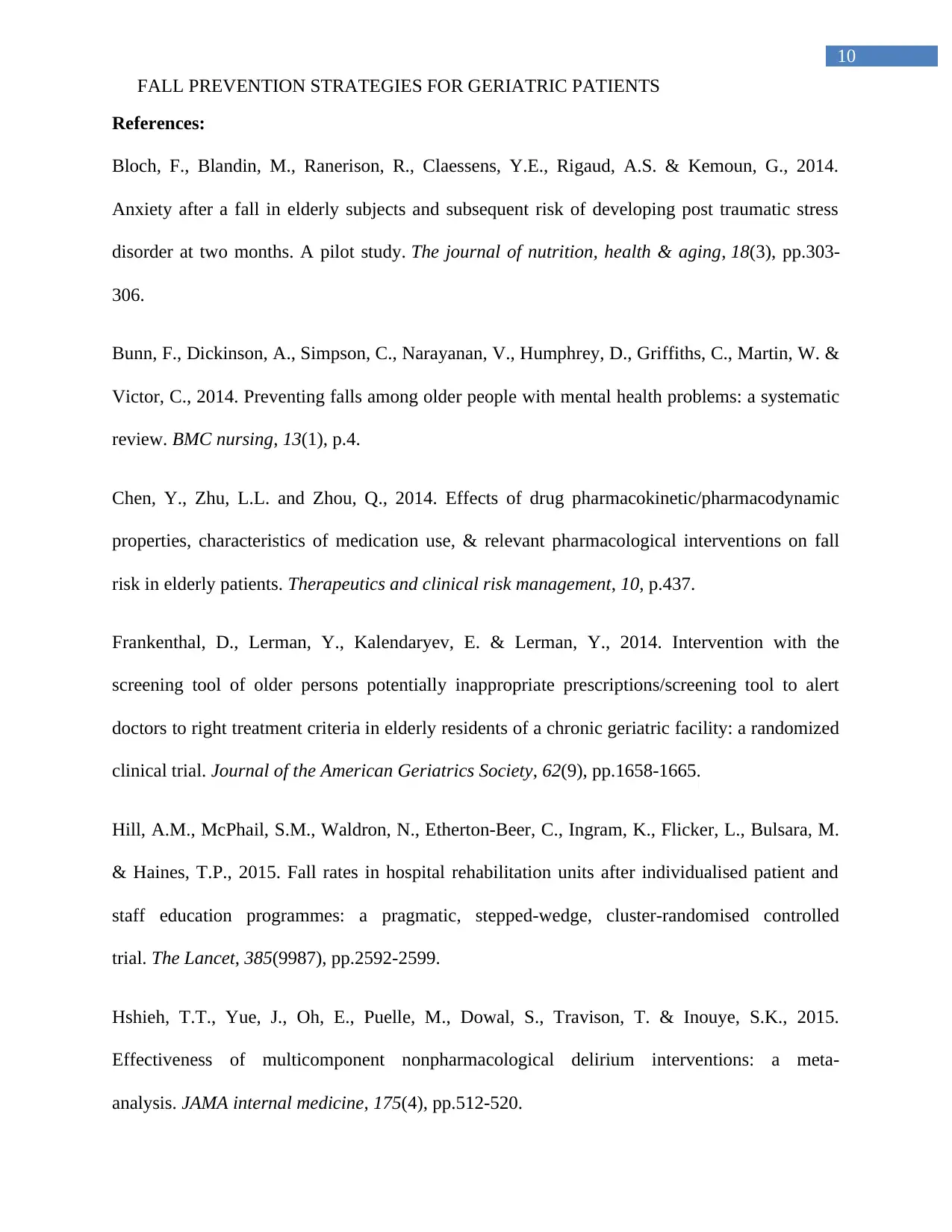
10
FALL PREVENTION STRATEGIES FOR GERIATRIC PATIENTS
References:
Bloch, F., Blandin, M., Ranerison, R., Claessens, Y.E., Rigaud, A.S. & Kemoun, G., 2014.
Anxiety after a fall in elderly subjects and subsequent risk of developing post traumatic stress
disorder at two months. A pilot study. The journal of nutrition, health & aging, 18(3), pp.303-
306.
Bunn, F., Dickinson, A., Simpson, C., Narayanan, V., Humphrey, D., Griffiths, C., Martin, W. &
Victor, C., 2014. Preventing falls among older people with mental health problems: a systematic
review. BMC nursing, 13(1), p.4.
Chen, Y., Zhu, L.L. and Zhou, Q., 2014. Effects of drug pharmacokinetic/pharmacodynamic
properties, characteristics of medication use, & relevant pharmacological interventions on fall
risk in elderly patients. Therapeutics and clinical risk management, 10, p.437.
Frankenthal, D., Lerman, Y., Kalendaryev, E. & Lerman, Y., 2014. Intervention with the
screening tool of older persons potentially inappropriate prescriptions/screening tool to alert
doctors to right treatment criteria in elderly residents of a chronic geriatric facility: a randomized
clinical trial. Journal of the American Geriatrics Society, 62(9), pp.1658-1665.
Hill, A.M., McPhail, S.M., Waldron, N., Etherton-Beer, C., Ingram, K., Flicker, L., Bulsara, M.
& Haines, T.P., 2015. Fall rates in hospital rehabilitation units after individualised patient and
staff education programmes: a pragmatic, stepped-wedge, cluster-randomised controlled
trial. The Lancet, 385(9987), pp.2592-2599.
Hshieh, T.T., Yue, J., Oh, E., Puelle, M., Dowal, S., Travison, T. & Inouye, S.K., 2015.
Effectiveness of multicomponent nonpharmacological delirium interventions: a meta-
analysis. JAMA internal medicine, 175(4), pp.512-520.
FALL PREVENTION STRATEGIES FOR GERIATRIC PATIENTS
References:
Bloch, F., Blandin, M., Ranerison, R., Claessens, Y.E., Rigaud, A.S. & Kemoun, G., 2014.
Anxiety after a fall in elderly subjects and subsequent risk of developing post traumatic stress
disorder at two months. A pilot study. The journal of nutrition, health & aging, 18(3), pp.303-
306.
Bunn, F., Dickinson, A., Simpson, C., Narayanan, V., Humphrey, D., Griffiths, C., Martin, W. &
Victor, C., 2014. Preventing falls among older people with mental health problems: a systematic
review. BMC nursing, 13(1), p.4.
Chen, Y., Zhu, L.L. and Zhou, Q., 2014. Effects of drug pharmacokinetic/pharmacodynamic
properties, characteristics of medication use, & relevant pharmacological interventions on fall
risk in elderly patients. Therapeutics and clinical risk management, 10, p.437.
Frankenthal, D., Lerman, Y., Kalendaryev, E. & Lerman, Y., 2014. Intervention with the
screening tool of older persons potentially inappropriate prescriptions/screening tool to alert
doctors to right treatment criteria in elderly residents of a chronic geriatric facility: a randomized
clinical trial. Journal of the American Geriatrics Society, 62(9), pp.1658-1665.
Hill, A.M., McPhail, S.M., Waldron, N., Etherton-Beer, C., Ingram, K., Flicker, L., Bulsara, M.
& Haines, T.P., 2015. Fall rates in hospital rehabilitation units after individualised patient and
staff education programmes: a pragmatic, stepped-wedge, cluster-randomised controlled
trial. The Lancet, 385(9987), pp.2592-2599.
Hshieh, T.T., Yue, J., Oh, E., Puelle, M., Dowal, S., Travison, T. & Inouye, S.K., 2015.
Effectiveness of multicomponent nonpharmacological delirium interventions: a meta-
analysis. JAMA internal medicine, 175(4), pp.512-520.
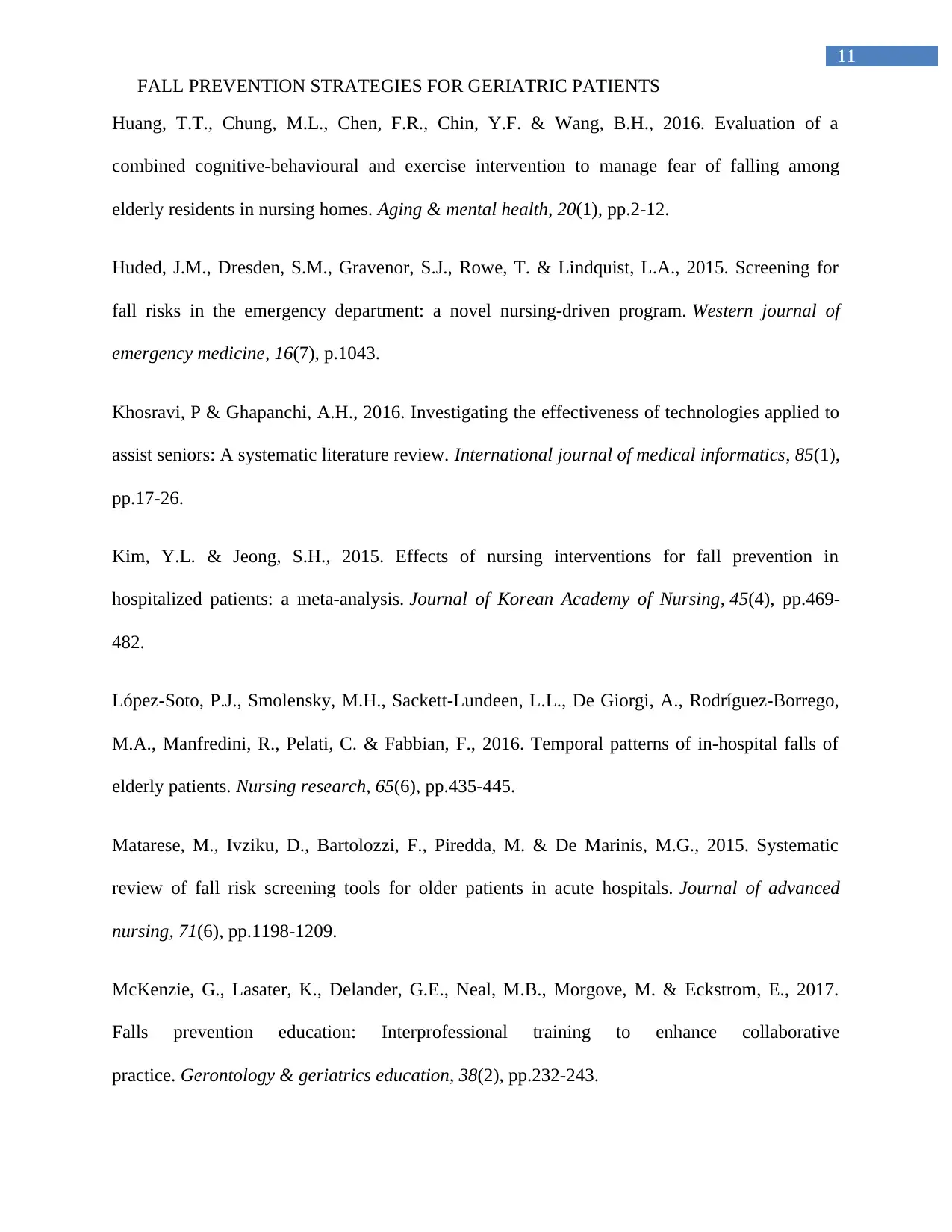
11
FALL PREVENTION STRATEGIES FOR GERIATRIC PATIENTS
Huang, T.T., Chung, M.L., Chen, F.R., Chin, Y.F. & Wang, B.H., 2016. Evaluation of a
combined cognitive-behavioural and exercise intervention to manage fear of falling among
elderly residents in nursing homes. Aging & mental health, 20(1), pp.2-12.
Huded, J.M., Dresden, S.M., Gravenor, S.J., Rowe, T. & Lindquist, L.A., 2015. Screening for
fall risks in the emergency department: a novel nursing-driven program. Western journal of
emergency medicine, 16(7), p.1043.
Khosravi, P & Ghapanchi, A.H., 2016. Investigating the effectiveness of technologies applied to
assist seniors: A systematic literature review. International journal of medical informatics, 85(1),
pp.17-26.
Kim, Y.L. & Jeong, S.H., 2015. Effects of nursing interventions for fall prevention in
hospitalized patients: a meta-analysis. Journal of Korean Academy of Nursing, 45(4), pp.469-
482.
López-Soto, P.J., Smolensky, M.H., Sackett-Lundeen, L.L., De Giorgi, A., Rodríguez-Borrego,
M.A., Manfredini, R., Pelati, C. & Fabbian, F., 2016. Temporal patterns of in-hospital falls of
elderly patients. Nursing research, 65(6), pp.435-445.
Matarese, M., Ivziku, D., Bartolozzi, F., Piredda, M. & De Marinis, M.G., 2015. Systematic
review of fall risk screening tools for older patients in acute hospitals. Journal of advanced
nursing, 71(6), pp.1198-1209.
McKenzie, G., Lasater, K., Delander, G.E., Neal, M.B., Morgove, M. & Eckstrom, E., 2017.
Falls prevention education: Interprofessional training to enhance collaborative
practice. Gerontology & geriatrics education, 38(2), pp.232-243.
FALL PREVENTION STRATEGIES FOR GERIATRIC PATIENTS
Huang, T.T., Chung, M.L., Chen, F.R., Chin, Y.F. & Wang, B.H., 2016. Evaluation of a
combined cognitive-behavioural and exercise intervention to manage fear of falling among
elderly residents in nursing homes. Aging & mental health, 20(1), pp.2-12.
Huded, J.M., Dresden, S.M., Gravenor, S.J., Rowe, T. & Lindquist, L.A., 2015. Screening for
fall risks in the emergency department: a novel nursing-driven program. Western journal of
emergency medicine, 16(7), p.1043.
Khosravi, P & Ghapanchi, A.H., 2016. Investigating the effectiveness of technologies applied to
assist seniors: A systematic literature review. International journal of medical informatics, 85(1),
pp.17-26.
Kim, Y.L. & Jeong, S.H., 2015. Effects of nursing interventions for fall prevention in
hospitalized patients: a meta-analysis. Journal of Korean Academy of Nursing, 45(4), pp.469-
482.
López-Soto, P.J., Smolensky, M.H., Sackett-Lundeen, L.L., De Giorgi, A., Rodríguez-Borrego,
M.A., Manfredini, R., Pelati, C. & Fabbian, F., 2016. Temporal patterns of in-hospital falls of
elderly patients. Nursing research, 65(6), pp.435-445.
Matarese, M., Ivziku, D., Bartolozzi, F., Piredda, M. & De Marinis, M.G., 2015. Systematic
review of fall risk screening tools for older patients in acute hospitals. Journal of advanced
nursing, 71(6), pp.1198-1209.
McKenzie, G., Lasater, K., Delander, G.E., Neal, M.B., Morgove, M. & Eckstrom, E., 2017.
Falls prevention education: Interprofessional training to enhance collaborative
practice. Gerontology & geriatrics education, 38(2), pp.232-243.
⊘ This is a preview!⊘
Do you want full access?
Subscribe today to unlock all pages.

Trusted by 1+ million students worldwide
1 out of 14
Related Documents
Your All-in-One AI-Powered Toolkit for Academic Success.
+13062052269
info@desklib.com
Available 24*7 on WhatsApp / Email
![[object Object]](/_next/static/media/star-bottom.7253800d.svg)
Unlock your academic potential
Copyright © 2020–2025 A2Z Services. All Rights Reserved. Developed and managed by ZUCOL.





